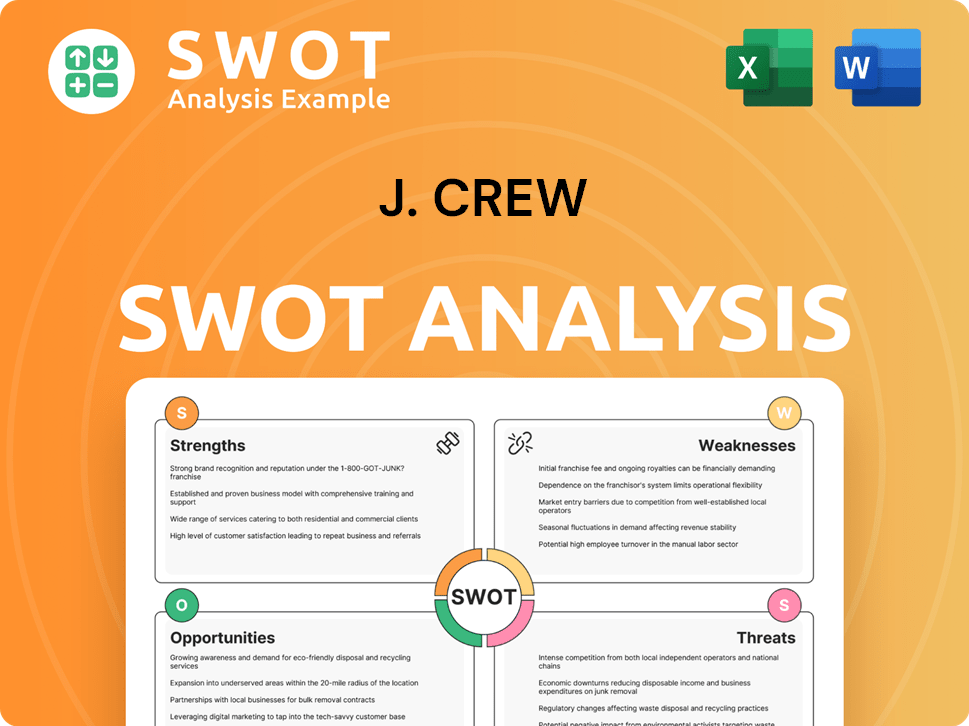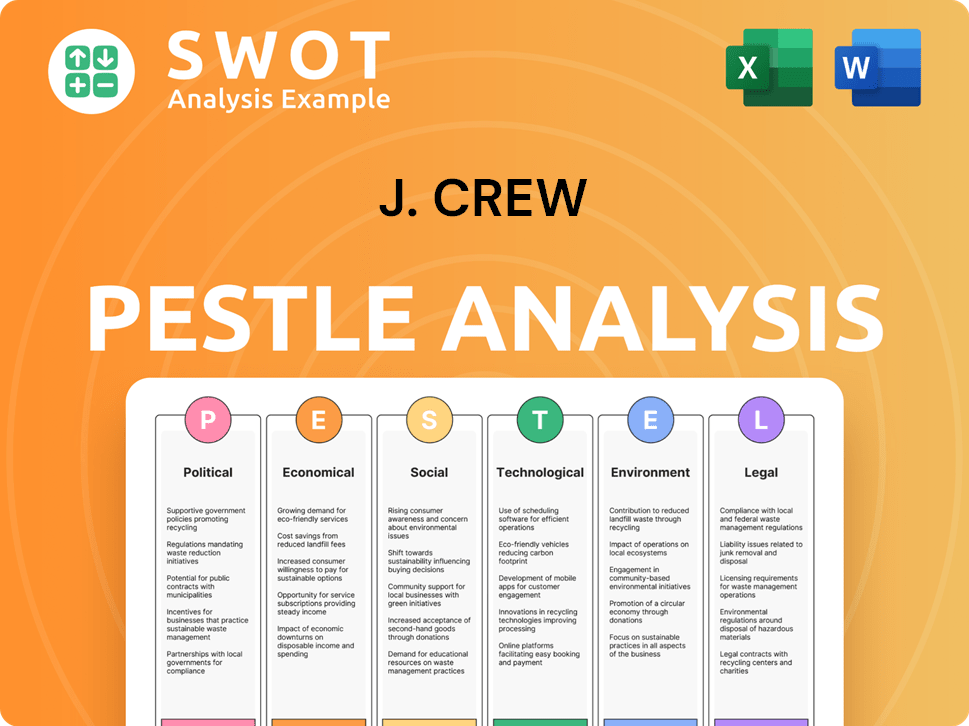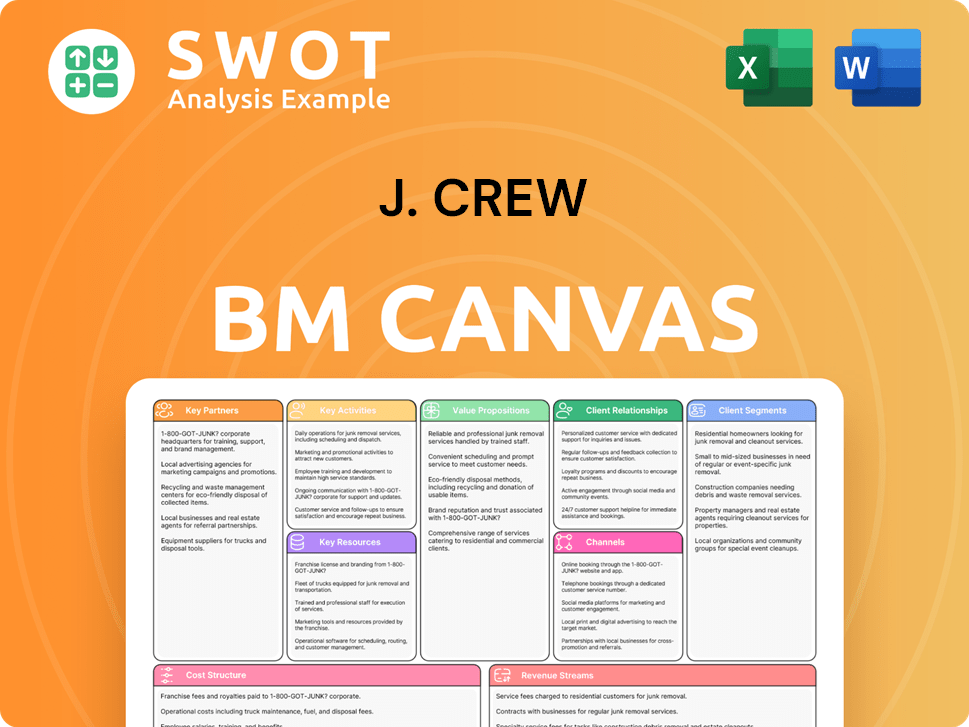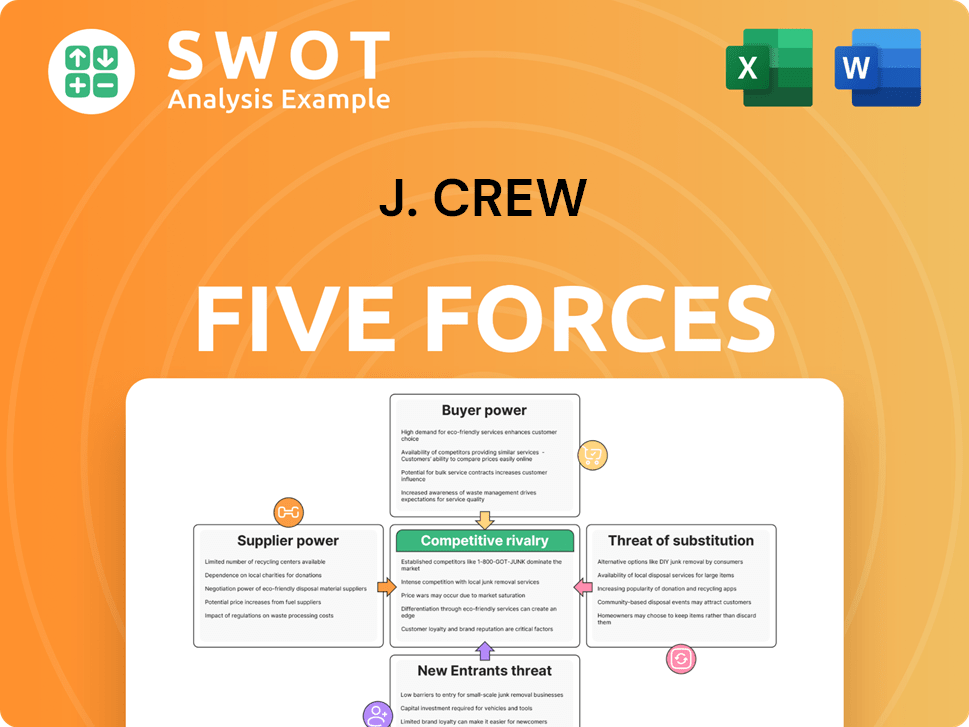J. Crew Bundle
How Did J. Crew Become a Fashion Icon?
J. Crew, a name synonymous with timeless American style, has a fascinating J. Crew SWOT Analysis that spans decades. From its humble beginnings as a catalog retailer in 1983, the J. Crew company has evolved into a multi-brand powerhouse, captivating consumers with its preppy aesthetic and commitment to quality clothing. But how did this brand, initially targeting college campuses, become a retail giant?

This article delves into the brief history of J. Crew, exploring its early days and the vision of its founder. We'll trace J. Crew's growth and evolution, highlighting key milestones that shaped its brand identity and its impact on the fashion industry. Furthermore, we will examine the company's resilience through financial struggles and its recent developments, offering insights into J. Crew's current status and future prospects.
What is the J. Crew Founding Story?
The story of the J. Crew company began in 1947, but the brand as we know it today emerged in the 1980s. This transformation involved a shift in focus and a new approach to reaching customers. The early days of J. Crew set the stage for its future success in the fashion industry.
The company's roots are in Popular Merchandise, Inc., founded by Mitchell Cinader and Saul Charles. They initially sold affordable women's clothing through in-home demonstrations. The evolution into J. Crew marked a significant change in strategy and branding, setting the stage for its growth.
The shift to the J. Crew brand happened in 1983. The company, then known as Popular Merchandise, Inc., became J. Crew, Inc. and launched its first catalog in January of that year. The name 'J. Crew' was chosen to evoke the sport of crew, with the 'J' added for visual appeal. This branding move was designed to compete with brands like Ralph Lauren's Polo label while offering a more accessible price point. The company's early success was fueled by its direct-to-consumer model and stylish clothing.
J. Crew's founding story is rooted in Popular Merchandise, Inc., which was established in 1947. The brand's focus on direct-to-consumer sales through catalogs played a pivotal role in its early success.
- Mitchell Cinader and Saul Charles founded Popular Merchandise, Inc. in 1947.
- The J. Crew brand was officially launched in 1983 with the first catalog.
- Arthur Cinader and Emily Cinader (Woods) were key in shaping the brand's aesthetic.
- The company aimed to compete with brands like Ralph Lauren while offering more affordable options.
Arthur Cinader, Mitchell Cinader's son, and his daughter Emily Cinader (later Woods) were instrumental in defining the J. Crew look. They focused on creating stylish, preppy clothing with a high-quality feel, targeting upper-middle-class customers. The initial business model centered on direct-to-consumer sales through glossy mail-order catalogs. These catalogs featured high-quality photography, portraying an aspirational American lifestyle. This marketing strategy proved highly effective, with sales reportedly growing by approximately 25% annually during the 1980s. The company's initial funding came from its existing operations as Popular Merchandise, Inc.
The company's early success was largely driven by its direct-to-consumer approach. The catalogs were a key part of this strategy, showcasing the brand's clothing in a visually appealing way. This helped J. Crew establish a strong presence in the market. For more insights into the competitive landscape, you can explore the Competitors Landscape of J. Crew.
J. Crew SWOT Analysis
- Complete SWOT Breakdown
- Fully Customizable
- Editable in Excel & Word
- Professional Formatting
- Investor-Ready Format

What Drove the Early Growth of J. Crew?
The early growth of the J. Crew company was marked by rapid expansion following its catalog launch in 1983. This period saw significant revenue increases, driven by the popularity of its direct-to-consumer model. The brand also made a strategic move into brick-and-mortar retail, enhancing its presence and customer experience.
Following the successful catalog launch, the J. Crew clothing brand experienced remarkable growth in the 1980s. Annual sales surged from $3 million to over $100 million within five years. This growth was primarily fueled by the effectiveness of its direct-to-consumer mail-order model, which allowed for widespread reach and customer engagement.
In 1989, the J. Crew company took a significant step by opening its first physical store in downtown Manhattan. This marked a strategic shift, complementing its successful catalog business. The retail stores provided customers with an opportunity to experience the brand in person, expanding its reach and enhancing brand visibility.
Throughout the 1990s and early 2000s, J. Crew continued to expand its retail presence across the United States, becoming a familiar name in shopping malls. The brand also ventured into international markets, sending catalogs to Canada in 1991 and opening retail stores in Japan through a joint venture in 1993. These moves broadened the company's global footprint.
A key moment in J. Crew's history was the acquisition of a majority stake by investment firm Texas Pacific Group Inc. in October 1997. This strategic move provided the company with new resources and direction. Further insights into the brand's core values can be found in this article about Mission, Vision & Core Values of J. Crew.
J. Crew PESTLE Analysis
- Covers All 6 PESTLE Categories
- No Research Needed – Save Hours of Work
- Built by Experts, Trusted by Consultants
- Instant Download, Ready to Use
- 100% Editable, Fully Customizable

What are the key Milestones in J. Crew history?
The J. Crew history is marked by significant achievements and challenging periods. The company's evolution showcases its ability to adapt to market changes and consumer preferences. Key milestones have shaped the brand's identity and influence in the fashion industry.
| Year | Milestone |
|---|---|
| 2003-2017 | The 'golden era' under CEO Mickey Drexler and Creative Director Jenna Lyons, significantly boosting the brand's popularity. |
| 2006 | Introduction of the 'J. Crew Collection', offering more luxurious and fashion-forward lines. |
| 2011 | Private-equity buyout burdened the company with heavy debt. |
| May 2020 | J. Crew Group filed for Chapter 11 bankruptcy, becoming the first major U.S. retailer to do so during the COVID-19 pandemic. |
| September 2020 | Emergence from bankruptcy after shedding $1.6 billion in debt. |
| 2021 | Launch of 'Re-imagined by J. Crew' and appointment of Brendon Babenzien for menswear. |
| Fall 2023 | Relaunch of its iconic catalog. |
Innovations at the J. Crew company included collaborations and expansion of product lines. These strategic moves aimed to enhance the brand's appeal and market reach.
In 2006, the introduction of the 'J. Crew Collection' expanded the brand's offerings. This line catered to a more fashion-forward audience, enhancing the brand's portfolio.
Collaborations with designers and brands like New Balance and Liberty London broadened the brand's appeal. These partnerships introduced fresh perspectives and expanded product categories.
The relaunch of the iconic catalog in Fall 2023, helped to reconnect with its customer base. This move aimed to re-establish brand identity and drive sales.
The launch of 'Re-imagined by J. Crew' in 2021, with goals to sustainably source key fibers. This initiative reflected a commitment to eco-friendly practices and appeal to environmentally conscious consumers.
Despite its successes, the J. Crew brand faced significant challenges, including financial struggles and shifts in consumer behavior. These factors led to strategic changes and efforts to revitalize the company.
By 2014, J. Crew experienced declining sales due to pushing trendier, more expensive styles. This shift alienated its core customer base and impacted financial performance.
The departure of key figures like Jenna Lyons and Mickey Drexler in 2017 signaled significant changes. These leadership transitions reflected the need for strategic adjustments.
In May 2020, the company filed for Chapter 11 bankruptcy, burdened by debt and declining sales. This event marked a critical turning point in the company's history.
Intense competition from fast-fashion retailers and shifting consumer preferences put pressure on the company. Adapting to these changes became crucial for survival.
The 2011 private-equity buyout left the company with significant debt, contributing to financial struggles. The debt load complicated efforts to adapt and grow.
As part of the restructuring, J. Crew closed all UK stores and numerous U.S. locations. These closures reflected strategic efforts to streamline operations and manage costs.
J. Crew Business Model Canvas
- Complete 9-Block Business Model Canvas
- Effortlessly Communicate Your Business Strategy
- Investor-Ready BMC Format
- 100% Editable and Customizable
- Clear and Structured Layout

What is the Timeline of Key Events for J. Crew?
The story of the J. Crew company, from its early days to its present status, is marked by significant milestones and strategic shifts. The J. Crew history reflects a journey from catalog retailer to a prominent fashion brand, facing both successes and challenges along the way. The J. Crew timeline reveals key moments that shaped its identity and market position. The J. Crew clothing line has evolved, reflecting changes in consumer preferences and market trends. The J. Crew brand has adapted to various economic and social landscapes, making it a compelling case study in retail evolution.
| Year | Key Event |
|---|---|
| 1947 | Mitchell Cinader and Saul Charles found Popular Merchandise, Inc. |
| 1983 | Popular Merchandise, Inc. becomes J. Crew, Inc., and mails its first catalog. |
| 1989 | J. Crew opens its first retail store in New York City's South Street Seaport. |
| 1997 | Texas Pacific Group Inc. acquires a majority stake. |
| 2003 | Millard 'Mickey' Drexler becomes CEO, initiating a 'golden era.' |
| 2006 | J. Crew launches Madewell and re-launches Crewcuts; company goes public. |
| 2011 | J. Crew is taken private again in a $3 billion leveraged buyout. |
| 2014 | Sales begin to decline as the brand alienates its core customer base. |
| 2017 | Jenna Lyons and Mickey Drexler step down. |
| May 2020 | J. Crew Group files for Chapter 11 bankruptcy. |
| September 2020 | J. Crew successfully emerges from bankruptcy. |
| Late 2020 | Libby Wadle becomes CEO of J. Crew Group. |
| 2021 | Brendon Babenzien becomes head of menswear; 'Re-imagined by J. Crew' sustainability initiative launched. |
| Fall 2023 | J. Crew relaunches its iconic catalog. |
| 2024 | Group-wide sales are on track to hit a record $3 billion. |
| January 2025 | Julia Collier appointed Chief Marketing Officer of J. Crew. |
| March 2025 | J. Crew announces a multiyear partnership with U.S. Ski & Snowboard. |
J. Crew is focused on sustainable sourcing, aiming for 100% of key fibers sustainably by 2025. The company plans to produce over 90% of its cashmere and chino collections in Fair Trade Certified facilities by 2025.
The company is enhancing its omnichannel performance and investing in its e-commerce platform. Data analytics will be utilized to create personalized customer experiences. J. Crew's April 2025 online revenue was $87,992,247.
J. Crew is forming strategic alliances, such as a multiyear partnership with U.S. Ski & Snowboard announced in March 2025. These partnerships aim to broaden the brand's reach and appeal.
New store openings, including women's and men's focused locations in New York City in spring 2024, indicate a continued emphasis on physical retail experiences. This expansion is part of J. Crew's strategy to reach new customers.
J. Crew Porter's Five Forces Analysis
- Covers All 5 Competitive Forces in Detail
- Structured for Consultants, Students, and Founders
- 100% Editable in Microsoft Word & Excel
- Instant Digital Download – Use Immediately
- Compatible with Mac & PC – Fully Unlocked

Related Blogs
- What is Competitive Landscape of J. Crew Company?
- What is Growth Strategy and Future Prospects of J. Crew Company?
- How Does J. Crew Company Work?
- What is Sales and Marketing Strategy of J. Crew Company?
- What is Brief History of J. Crew Company?
- Who Owns J. Crew Company?
- What is Customer Demographics and Target Market of J. Crew Company?
Disclaimer
All information, articles, and product details provided on this website are for general informational and educational purposes only. We do not claim any ownership over, nor do we intend to infringe upon, any trademarks, copyrights, logos, brand names, or other intellectual property mentioned or depicted on this site. Such intellectual property remains the property of its respective owners, and any references here are made solely for identification or informational purposes, without implying any affiliation, endorsement, or partnership.
We make no representations or warranties, express or implied, regarding the accuracy, completeness, or suitability of any content or products presented. Nothing on this website should be construed as legal, tax, investment, financial, medical, or other professional advice. In addition, no part of this site—including articles or product references—constitutes a solicitation, recommendation, endorsement, advertisement, or offer to buy or sell any securities, franchises, or other financial instruments, particularly in jurisdictions where such activity would be unlawful.
All content is of a general nature and may not address the specific circumstances of any individual or entity. It is not a substitute for professional advice or services. Any actions you take based on the information provided here are strictly at your own risk. You accept full responsibility for any decisions or outcomes arising from your use of this website and agree to release us from any liability in connection with your use of, or reliance upon, the content or products found herein.